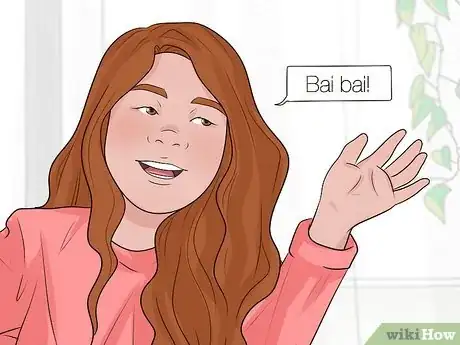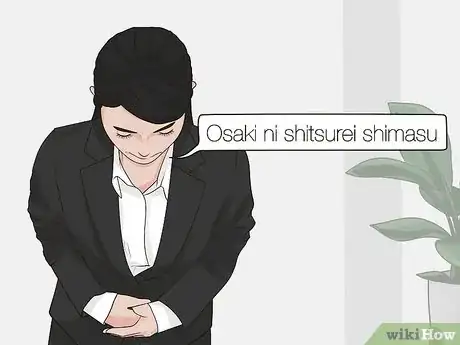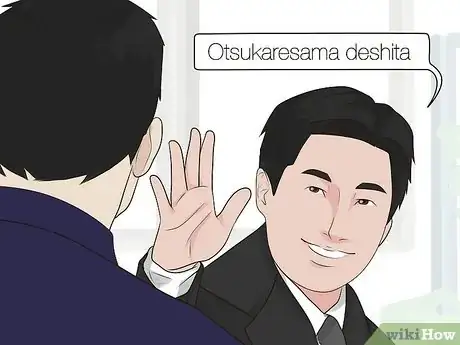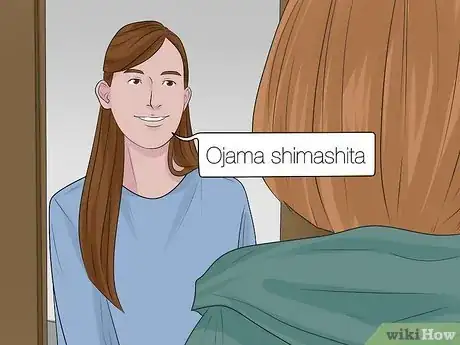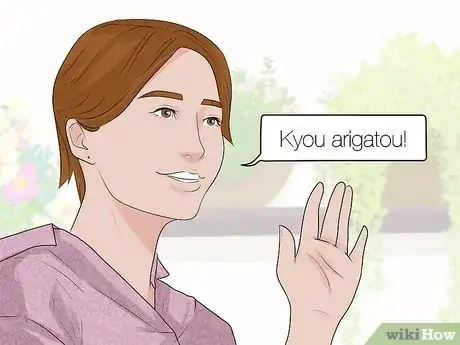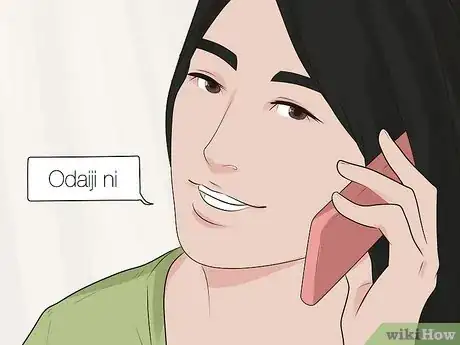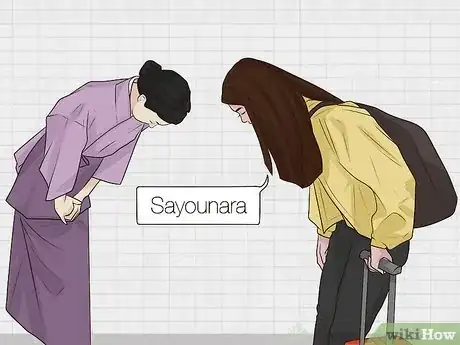This article was co-authored by Language Academia and by wikiHow staff writer, Janice Tieperman. Language Academia is a private, online language school founded by Kordilia Foxstone. Kordilia and her team specialize in teaching foreign languages and accent reduction. Language Academia offers courses in several languages, including English, Spanish, and Mandarin.
There are 11 references cited in this article, which can be found at the bottom of the page.
This article has been viewed 3,727 times.
Looking to brush up on your Japanese? Learning how to say “bye” is a great starting point, but it isn’t quite as simple as saying “sayounara.” Japanese is a nuanced language that’s rooted in politeness, formality, and an understanding of who you’re talking to. So, there are actually multiple ways to say “bye” and “see ya,” depending on where you are and who you’re speaking with. Not to worry—we’ve gone over lots of different ways to say bye in Japanese, so you’ll be prepared for just about any situation.
Steps
Jaa ne (じゃあね)
-
Use “jaa ne” to say “bye” to your friends and loved ones. Think of “jaa ne” as a quick “Bye!” or “See ya!” you’d offer a friend or close family member before going your separate ways for the day. It’s a pretty casual way of saying “bye,” so you wouldn’t use it when saying goodbye to an authority figure, like your boss.[1] X Research source
- You can also casually say “bye” to friends with “じゃあ、また” (jaa, mata) or “またね” (mata ne).
- じゃあね (jaa ne), じゃあ、また (jaa, mata), and またね” (mata ne) all essentially mean the same thing.
Mata ashita (また明日)
-
Use “mata ashita” if you plan on seeing someone the next day. “明日” (ashita) directly translates to “tomorrow,” which makes “mata ashita” the perfect thing to say to a friend or co-worker that you plan on bumping into the next day.[2] X Research source
- This is a pretty informal phrase, so you shouldn’t use it when saying “bye” to an authority figure.
-
Co-worker: “またね!” (mata ne)
You: “また明日!” (mata ashita)
Bai bai (バイバイ)
-
Keep things casual and cute with “bai bai.” “Bai bai” is the Japanese variation of the English word “bye.” Since it’s such a laid-back saying, most people only say it to their close friends.[3] X Research source
- In Japan, “bai bai” is considered a really cutesy and feminine way to say goodbye, so guys usually don’t say it.
-
Friend: “じゃあね!” (jaa ne)
You: “バイバイ!” (bai bai)
Ittekimasu (行って来ます)
-
Say a quick “ittekimasu” before you head out for the day. In Japan, people always say “ittekimasu” to the other members of their household before leaving. It literally translates to “I’ll be going now” or “I’m leaving home,” but it carries the same weight as “bye.”[4] X Research source In response, another member of the household will say “行ってらっしゃい” (itterasshai), which means “see you later.”[5] X Research source
-
You: “行って来ます!” (ittekimasu)
Parent/Guardian: “行ってらっしゃい!” (itterasshai)
-
You: “行って来ます!” (ittekimasu)
Tanoshinde ne (楽しんでね)
-
Wish someone a good time with “tanoshinde ne.” Maybe your brother is about to head out to the beach, or your friend is heading to a fun party.[6] X Research source Before you split up and they head off, say “tanoshinde ne” as a way to both say “bye” and “enjoy your day.”
- “Tanoshinde ne” is a pretty casual phrase, and is best used with friends, loved ones, and other people you know well.
-
Friend: “じゃあ、また!” (jaa, mata)
You: “楽しんでね!” (tanoshinde ne)
Oyasumi nasai (おやすみなさい)
-
Use “oyasumi nasai” when you’re parting ways at night. “おやすみなさい”(oyasumi nasai) literally translates to “good night,” and is a great way to wish someone well before heading home in the evening. If you’re really friendly with the person you’re speaking to, you can say “おやすみ” (oyasumi) rather than “おやすみなさい” (oyasumi nasai).[7] X Research source
-
Friend: “またね!” (mata ne)
You: “おやすみ!” (oyasumi)
-
Friend: “またね!” (mata ne)
Osaki ni shitsurei shimasu (お先に失礼します)
-
Make a polite exit with “osaki ni shitsurei shimasu.” “お先に失礼します” (osaki ni shitsurei shimasu) means “I’m heading out before you.” It’s a polite way of saying “bye” as you excuse yourself, and also means “See you tomorrow!”[8] X Research source
- If you were heading out from work before your supervisor, you could say “お先に失礼します” (osaki ni shituserei shimasu) to be polite.
Otsukaresama deshita (お疲れ様でした)
-
Say goodbye to your coworkers with “otsukaresama deshita.” “お疲れ様でした” officially translates to “You must be tired,” but people use this phrase to mean “Thank you for your hard work.” Co-workers typically say this to each other as a way of saying “bye” when they leave for the day.[9] X Research source
- “お疲れ様でした” (otsukaresama deshita) is the formal version of this phrase, while “お疲れ様” (otsukaresama) is the informal version. If you’re pretty tight with the co-workers you’re saying “bye” to, feel free to just say “お疲れ様” (otsukaresama).
Ojama shimashita (お邪魔しました)
-
Say “ojama shimashita” before leaving someone’s home. You just spent the afternoon at a friend’s home and you’re getting ready to head out. “お邪魔しました” (ojama shimashita) means “thank you for having me,” and is a polite way to say “bye” before you leave.[10] X Research source
Kyou arigatou (今日ありがとう)
-
Use “kyou arigatou” to say “thanks for today.” “今日” (kyou) translates to “today,” and “ありがとう” translates to “thank you.”[11] X Research source You’d say this before heading home after spending a fun day with someone.
- If you and your friend spent the day at an amusement park, you’d say “今日ありがとう” (kyou arigatou) before returning home.
Odaiji ni (お大事に)
-
Wish a sick friend well with “odaiji ni.” Maybe you drop some food off at your sister’s home when she’s feeling under the weather, or you call to check up on a friend who caught a cold. Before leaving or hanging up, you’d say “お大事に” (odaiji ni) as a hybrid of “goodbye” and “get well soon.”[12] X Research source
Genki de (元気で)
-
Say “genki de” if you might not see the other person for a little while. “元気で” (genki de) translates to “all the best” or “take care.” It’s a good way to say “bye” to someone that you might not see for a little bit, like a friend heading on month-long trip or a sibling studying abroad.[13] X Research source
- This is a good thing to say to your loved ones, friends, and co-workers.[14] X Research source
Ki wo tsukete (気をつけて)
-
Wish someone well on a trip with “ki wo tsukete.” “気をつけて” (ki wo tsukete) basically translates to “be careful,” and is a nice way to say “bye” to someone before they travel somewhere. It’s typically said to the person leaving, not to whoever is staying put.[15] X Research source
- For example, you’d say “ “気をつけて” (ki wo tsukete)” to a friend going on a month-long trip abroad, but you wouldn’t say it to a friend after hanging out with them for the afternoon.
- To make this phrase a little more formal, say “気をつけてください” (ki wo tsukete kudasai).[16] X Research source
Sayounara (さようなら)
-
Use “sayounara” if you don’t know when you’ll see the person again. Although “さようなら” (sayounara) does translate to mean “goodbye,” it doesn’t have the same casual, light-hearted connotation that the English “bye” or “goodbye” has. In Japanese, “さようなら” implies that you won’t be seeing the person for a very long time, so it shouldn’t be used often.[17] X Research source
- There’s a lot of misinformation out there about “さようなら” (sayounara) being the standard goodbye greeting. This definitely isn’t true—in fact, you’ll probably get some strange looks if you say “sayounara” to a native Japanese speaker.
You Might Also Like
 What Do the Chinese or Kanji 💮 🈶️ 🉑️ Emojis Mean?
What Do the Chinese or Kanji 💮 🈶️ 🉑️ Emojis Mean?


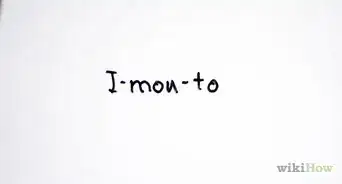










References
- ↑ https://gyl-magazine.jp/goodbye-in-japanese/
- ↑ https://gyl-magazine.jp/goodbye-in-japanese/
- ↑ https://gyl-magazine.jp/goodbye-in-japanese/
- ↑ https://gyl-magazine.jp/goodbye-in-japanese/
- ↑ https://gogonihon.com/en/blog/everyday-japanese-phrases/
- ↑ https://thelanguagequest.com/have-a-good-day-in-japanese/#Have_a_Good_Day_in_Japanese
- ↑ https://www.japaneseprofessor.com/lessons/beginning/greetings-and-other-expressions/
- ↑ https://www.youtube.com/watch?v=m9BPjQCS7Zw&t=5m34s
- ↑ https://www.japaneseprofessor.com/lessons/beginning/greetings-and-other-expressions/
- ↑ https://sagajet.com/newcomers/school-life/japanese-etiquette-and-manners/etiquette-and-manners-cheat-sheet/
- ↑ https://www.japaneseammo.com/thank-you-for-youre-welcome-in-japanese-native-way/
- ↑ https://inlinguakuwait.com/2015/11/24/suitable-methods-to-say-goodbye-in-japanese/
- ↑ https://inlinguakuwait.com/2015/11/24/suitable-methods-to-say-goodbye-in-japanese/
- ↑ https://90dayjapanese.com/goodbye-in-japanese/
- ↑ https://injapan.gaijinpot.com/uncategorized/2012/12/31/be-careful/
- ↑ https://teamjapanese.com/goodbye-in-japanese/#ki-wo-tsukete-kudasai
- ↑ https://gyl-magazine.jp/goodbye-in-japanese/
About This Article



